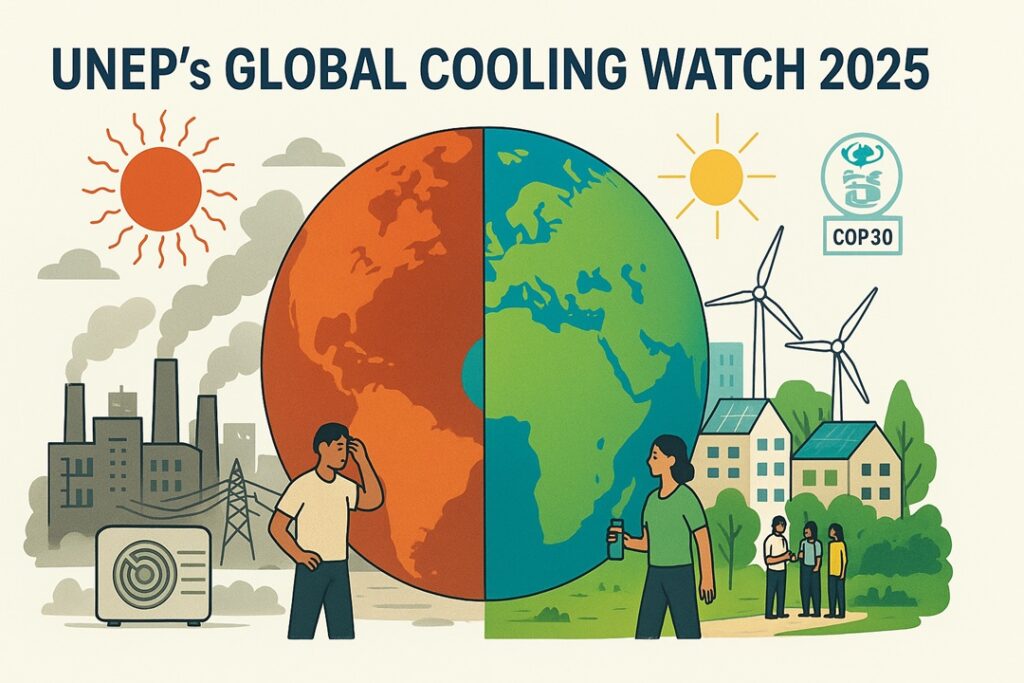UNEP’s Global Cooling Watch 2025: Addressing Cooling Inequality and Energy Burden

Context:
At COP30 in Belém, Brazil, the United Nations Environment Programme (UNEP) released the Global Cooling Watch 2025 Report, warning that global cooling demand could triple by 2050 under a business-as-usual scenario. This surge could potentially double emissions and strain global power systems, posing a major challenge to climate goals.
About Global Cooling Watch 2025 Report
What it is:
The Global Cooling Watch 2025 is UNEP’s second comprehensive global assessment examining the environmental, economic, and equity aspects of cooling. It provides the scientific foundation for the Global Cooling Pledge.
Published by:
United Nations Environment Programme (UNEP) at COP30 (2025).
Aim:
To analyse global cooling trends, project future emissions, and propose a “Sustainable Cooling Pathway” to achieve near-zero emissions while ensuring equitable access to cooling globally.
Key Trends Identified
Rising Cooling Demand:
Global cooling capacity is projected to increase 2.6 times (22 TW to 58 TW) by 2050, driven by urbanization, income growth, and extreme heat events, especially in developing countries.
Emission Surge:
Without effective policies, cooling-related GHG emissions could reach 10.5 billion tons of CO₂e by 2050—almost double 2022 levels—jeopardizing progress in other climate mitigation areas.
Developing Country Growth:
Cooling demand in Article 5 (developing) countries may increase fourfold, revealing a widening gap in energy access and infrastructure between developed and developing economies.
Energy Consumption:
Electricity use for cooling is expected to grow from 5,000 TWh (2022) to 18,000 TWh (2050), potentially overloading power grids and increasing peak energy demand, especially in tropical regions.
Heat Inequality:
Over 2 billion people in low-income households remain vulnerable to heat stress due to limited access to affordable, efficient cooling technologies.
Passive Cooling Potential:
Techniques such as reflective roofing, urban greening, and building design optimization can reduce indoor temperatures by up to 8°C and cut energy use by 15–55%, making them key adaptation tools.
HFC Transition:
Phasing down high-global-warming refrigerants (HFCs) and adopting low-GWP alternatives could prevent up to 0.4°C of global temperature rise this century.
Global Cooling Pledge Progress:
So far, 72 countries and 80 organizations have joined the Global Cooling Pledge, collectively targeting a 68% reduction in cooling sector emissions by 2050.
Successes
- Strengthened international cooperation through the Global Cooling Pledge, promoting shared standards and knowledge exchange.
- Integration of passive cooling strategies in building codes and urban planning, notably across Asia and Africa.
- Significant technological advancements in hybrid and low-energy cooling systems, achieving up to 50% higher efficiency.
- Expanded private sector participation in sustainable cooling technology manufacturing and financing.
- Emerging Tiered Access Frameworks improving cooling equity and resilience among vulnerable populations.
Limitations
- Persistent inequality in access, leaving millions in tropical developing regions exposed to lethal heat.
- Insufficient adaptation finance, with current funding meeting less than 20% of global resilience needs.
- Fragmented policies across energy, housing, and environmental sectors, hindering unified governance.
- Delayed HFC phase-down and inadequate refrigerant disposal increasing direct emissions.
- Heavy reliance on fossil-based electricity weakening efficiency and refrigerant transition benefits.
UNEP Recommendations
- Adopt a Sustainable Cooling Pathway integrating passive design, efficient appliances, and renewable energy.
- Accelerate refrigerant phase-down under the Kigali Amendment and ensure lifecycle refrigerant recovery.
- Mobilize green finance through concessional loans, PPPs, and climate bonds to expand sustainable cooling access.
- Mandate passive cooling standards in building codes and urban planning regulations.
- Promote equitable access by subsidizing efficient cooling for low-income and heat-stressed communities.
Conclusion
The Global Cooling Watch 2025 Report highlights that unchecked cooling demand poses a severe risk to achieving global climate goals. A coordinated global shift toward efficient, equitable, and low-emission cooling systems is essential.
If implemented promptly, UNEP’s Sustainable Cooling Pathway could reduce up to 97% of future emissions and secure a climate-safe, heat-resilient future for all.
Source : UNEP
